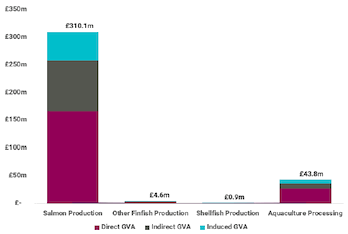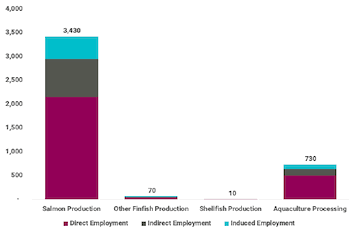Aquaculture sector - wider economic impacts: estimates
This study provides the estimates of the direct, indirect and wider economic impacts of the Scottish aquaculture sector for 2018, including associated tax receipt estimates.
5. Supply Chain Impact
This section estimates the economic impact that is associated with spending on the goods and services which supports the operations of the aquaculture sector in Scotland.
5.1 Supply Chain Expenditure
The Scottish aquaculture sector stimulates economic activity through its spending on goods and services. This expenditure, be it operational or on capital, supports the turnover and employment of those businesses where money is spent.
It was estimated that in 2018 the Scottish aquaculture sector spent £834.6 million externally in its supply chain. Based on the findings on Scottish supply chain content, it was estimated that around £634.7 million were spent in Scotland. The level of estimated expenditure, both globally and within Scotland, is shown in Table 5‑1. As with the survey respondents, the largest component of expenditure is within the manufacturing sector.
Table 5‑1 Supply Chain Expenditure of the Aquaculture Sector in 2018
| Sector | Expenditure in Scotland (£ million) | Total Expenditure (£ million) |
|---|---|---|
| Agriculture, forestry and fishing | 20.5 | 30.0 |
| Mining and quarrying | - | - |
| Manufacturing | 374.7 | 409.1 |
| Electricity, gas, steam and air conditioning SUPPLY | 2.7 | 6.5 |
| Water supply, sewerage, waste management and remediation activities | 2.5 | 3.9 |
| Construction | 63.3 | 119.2 |
| Wholesale and retail trade; repair of motor vehicles and motorcycles | 15.9 | 16.3 |
| Transport and storage | 31.1 | 52.8 |
| Accommodation and food service activities | 0.5 | 0.9 |
| Information and communication | 0.6 | 1.8 |
| Financial Services (Not in ABS) | 9.2 | 12.0 |
| Real estate activities | 0.1 | 0.1 |
| Professional, scientific and technical activities | 7.1 | 8.9 |
| Administrative and support service activities | 105.8 | 171.8 |
| Public administration and defence; compulsory social security | - | - |
| Education (Private Provision Only) | 0.3 | 0.7 |
| Human health and social work activities | 0.1 | 0.2 |
| Arts, entertainment and recreation (excluding gambling) | 0.4 | 0.5 |
| Other service activities | - | - |
| Total Reported Supply Spend | 634.7 | 834.6 |
Source: BiGGAR Economics Analysis
5.2 Supply Chain Impact
Having established the sectors where supply spending took place, it was then possible to estimate the economic activity that was supported by this expenditure. To allow for a more detailed analysis, procurement data were used to map supply chain expenditure at a Standard Industrial Classification (SIC) level 2. To estimate Gross Value Added (GVA) and direct employment, the turnover in each sector for each of the aquaculture subsectors was divided by the relevant Scottish turnover per GVA and turnover per job ratios from the Scottish Annual Business Statistics (SABS)[8].
It was then necessary to account for the indirect and induced impact that were generated across the supply chain. The former refers to the economic activity that is supported by suppliers of the aquaculture sector purchases of goods and services. The latter refer to the economic impact generated by the employees of businesses across the supply chain spending their salaries and wages in the economy. To estimate the indirect and induced GVA and employment impacts it was necessary to apply GVA and employment Type 1 and Type 2 Scottish multipliers from the Scottish Input-Output Tables[9][10].
In this way, it was estimated that in 2018 the Scottish aquaculture sector through its supply chain spending contributed £359.4 million GVA and supported 4,250 jobs across Scotland.
| GVA (£ million) | |
|---|---|
| Direct | 196.2 |
| Indirect | 102.5 |
| Induced | 60.6 |
| Total | 359.4 |
| Employment | |
| Direct | 2,700 |
| Indirect | 970 |
| Induced | 580 |
| Total | 4,250 |
Source: BiGGAR Economics Analysis.
*Totals may not add up due to rounding.
Within Scottish aquaculture, in 2018 salmon production contributed around £310 million GVA or about 86% of the total contribution made by the sector’s supply expenditure. The processing of aquaculture produce contributed 12%, whereas the remainder 2% of impact was attributable to spending taking place as a result of shellfish production or other finfish production.

Source: BiGGAR Economics Analysis
In 2018, salmon production supported 3,430 jobs or about 81% of the employment associated with supply chain spending. Aquaculture processing accounted for 17% of the employment supported through supply chain spending, whereas finfish and shellfish contributed around 2% of employment.

Source: BiGGAR Economics Analysis
Contact
There is a problem
Thanks for your feedback